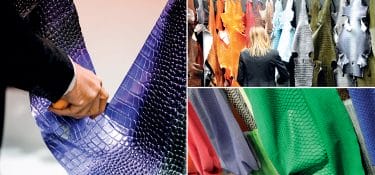Traditionally associated to manual know-how, the process of the leather-textile-footwear chain is undergoing change under the force of the fourth industrial revolution. A European project explains which types of professional figures the industry needs
By Roberto Procaccini
Let’s start with the process with which we evaluate raw material to be tanned. until today, this phase was assigned to the watchful eyes of expert workers that had gained much experience throughout time. They would check the pieces of leather one by one and then re-evaluate them after they have gone through the phase that prepares them to receive tanning agents (chemicals). That has been the tradition so far. But now digital machines with the capacity to scan leather and – instantly – highlighting details, defects and characteristics are being developed, which as of now takes time and has to be done after the tumbling process.
A slow and analogic process is ready to become fast and digital. The first reaction is to say that the job of “leather quality controller” at the start of the process will slowly disappear. But it rather transforms: it changes along with the new available tools: it no longer re- quires certain competencies, but it demands other ones.
This fourth industrial revolution is modifying the manufacturing process of European fashion. Some new tool, such as CAD drawings and retail novelties are just the tip of the iceberg. The digital side of the industry, considering the tanning, footwear, and textile-clothing segments, already employs two million people in the old continent. This digital revolution doesn’t just change the job itself because it also changes the location in which the job is done, all while transferring the information necessary to make up the value of goods via communicating supply-chain transparency. The chain is clearly thirsty for new knowledge: the number of specialized workers operating in this segment of the chain will reach 41,000 in the next five years.
These are all the conclusions reached by Digital TCLF, project that was co-financed by the Erasmus+ program of the European union and supported by, among others, Cotance (European Confederation of the Leather Industry) and CEC, similar organization of the footwear segment.
The market mainly needs nine types of professionals. And according to the 96 companies with more than 10 employees that answered TCLF’s survey, (out of the 205 total that answered to make up the sample), businesses operating in the fashion industry will be ready to hire, in the next five years, more than 7,000 Supply Chain Data Managers, around 1,000 Leather Technologists and about the same number of Finishing Technicians. “These are estimates based on the data collected through the sample at our disposal – explain the surveyors -. They are not to be taken as the exact indication of 2023 occupational levels. Additionally, certain capabilities may be found within the same person”. Yet, the indication that the job market is changing remains, and most of all remains “the necessity to offer adequate training – concludes Gustavo Gonzalez-Quijano, secretary general of Cotance -: we simply cannot teach new jobs with old training tools”.










